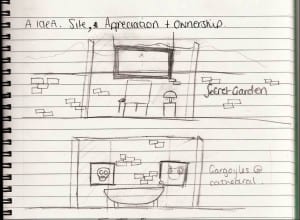Last week’s research in and around Lincoln Cathedral inspired us to delve deeper into the layers of perception that are attached to ‘well known’ buildings such as the Cathedral. But how would you describe the phrase ‘well known’? Is there just one way of knowing something, does everyone know the same thing? There is so much to know about one site, there is always going to be something you didn’t know, be that a fact or fiction. We went away after last week’s session and asked our housemates to tell us about a picture, (the headless statues on the cathedral). We then compared our findings and had a handful of interpretations on one single site. This abundance of layers from one stimulus is similar to Sophie Calle’s work Take Care of Yourself (2007). She created ‘a survey of interpretation’ (Fisher, 2009) by asking 107 women to share their opinion on a single email. These opinions that both Sophie Calle and our group received were ‘translations of reality’ (ibid, 2009), not necessarily fact, but translations of real thought and imagination. Several participants of our research told elaborate stories, obviously untrue, about the headless statues. One person stated that two people stole from the king and as punishment they were beheaded; their bodies were turned into stone and placed on the cathedral as a warning, whilst their heads were left to haunt the steps of steep hill. Although obviously a fictional story, this has now personally made me understand the cathedral in a different light. Forced Entertainment’s Nights in this City (1995) sort to write over Sheffield’s conventional history and tell their own. I found that this related a lot to our idea of portraying a different side to something people believe they know so well. They explored ‘the different histories written in urban space – the official history, the personal, the mythical and the imaginary’ (Etchells, 1999, 80) and ‘avoided facts in search of a different truth’ (ibid, 1999, 80). Personal truths are just as valid as fact. Children have the most elaborate imagination and don’t possess the social filter that strikes us down as we grow up. Their minds are much more open to interpretation and can see places and objects with a more imaginative outlook. How a child would perceive the cathedral might be very different to how an adult would. This childish truth was something we also wanted to explore. Tim Echells’ That Night Follows Day (2007) explored relationship between adults and children and how what adults say can influence a child. (Click here for video) This made me think of the natural hierarchy of adults and children, making me wonder what would happen if we reversed the roles. Through the use of audio, a child could take a group of adults for a tour around the cathedral grounds telling them their ‘truth’, putting them in control of what the adults hear.
Also within our research we discovered the advantages of audio recordings. Hearing first-hand opinions allowed a sense of honesty to come across. We then came up with the idea of a possible audio tour to make it more of a personal experience. Linked (2003) by Greame Miller was something that caught my eye regarding the way the audience were in control of the performance through audio. They were given an mp3 player and left to follow the map at their own speed, and their own time. This independence of the audience really interested me. I thought about how using the audio could enhance the audience’s experience during the performance, and also before/after. I thought about the possibility of making mp3 downloads of the recordings for the audience to download prior to the performance on their own devices, and using their own headphones to listen to it during the performance. This would make the performance more casual, and puts them in control of their experience, engaging them with the site before they even get there. Moreover, through downloading the files on their own devices they are able to keep them. Maybe one day they’ll stumble across it on their iPod and it will make them think about the performance again. Leaving them with a token of their experience, similar to the books from Proto-type Theatre’s performances.
Etchells, T. (1999) Certain Fragments: Contemporary Performance and Forced Entertainment. London: Routledge.
Fisher, C. (2009) Sophie Calle: Take Care of Yourself. [online] Brooklyn: The Brooklyn Rail. Available from http://www.brooklynrail.org/2009/06/artseen/take-care-of-yourself [Accessed 28 February 2015].

